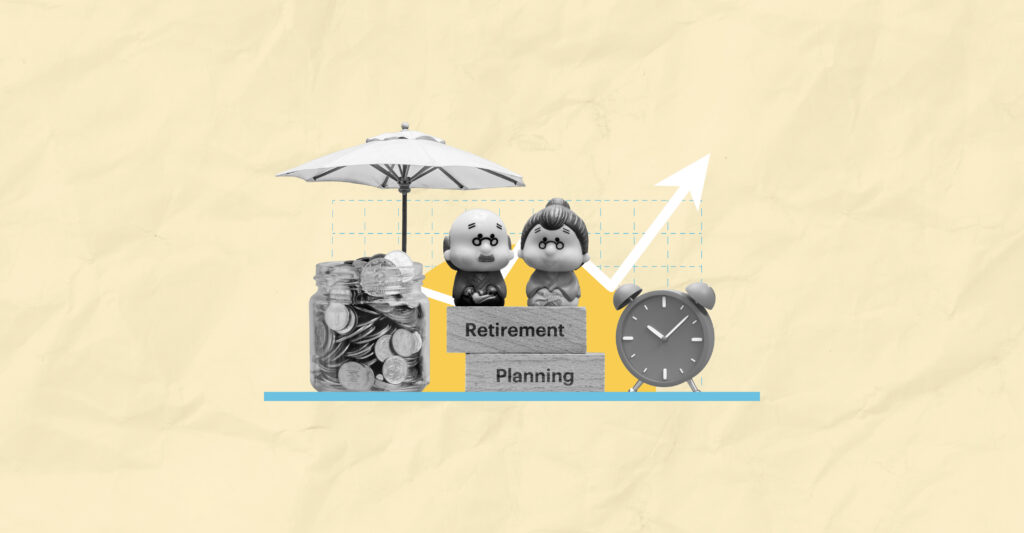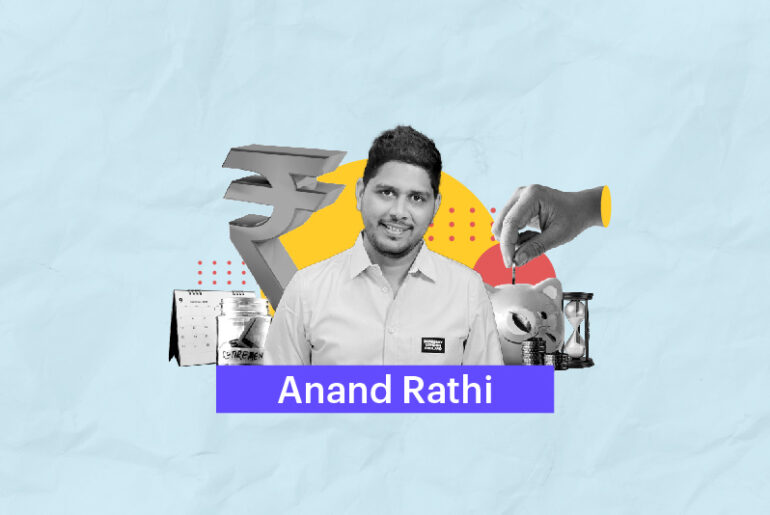Last Updated on Aug 25, 2022 by Aradhana Gotur
Table of Contents
What is retirement planning?
Retirement planning means preparing for life after retirement today so you can enjoy comfortable sunset years without making a major change in your lifestyle. It entails setting retirement goals, identifying potential expenses, estimating the funds needed to meet them, investing money to accumulate a retirement fund, and managing assets and risk.
Why plan for retirement?
No one wants to work till the very end. And no one wants to pick up odd or part-time jobs after retirement. So, the reason to plan for your retirement is simple – to accumulate enough funds during your working years to support your daily, non-recurring, and unplanned expenses after retiring.
You may not have a regular source of income to support your lifestyle after you stop working. Even if you do have a pension coming in, ask yourself if it would be sufficient to sustain your desired lifestyle and also support your dependents, if any. Below are the concrete reasons why you should plan retirement:
- India doesn’t have a social security system with retirement benefits for senior citizens. Pensions and EPF would not be sufficient to cover your living plus medical expenses.
- Retirement planning negates or at least reduces your dependence on your children for support in your old age.
- Living costs only rise and do not decrease over time. So you need to consider inflation when planning for your retirement. After all the handwork you put in through your working years, you would not want to compromise on your living standards when you finally retire.
- In your old age, you would incur relatively higher healthcare expenses. Add medical inflation to this, and you would immediately realise the need to plan for your retirement. You may compromise on other goals but cannot dismiss your health and well-being.
- Planning your sunset years in advance can also help you carve out a clear path to achieve your retirement goals without compromising on other life goals.
Secret of a successful retirement plan
The guru mantra for a successful retirement plan is to start as early as you can. You know, the early birds catch the worm. Similarly, the sooner you start planning for your early days, the more time you will allow your money to multiply. That’s correct, not to grow simply but to multiply.
Compounding power
Assuming a moderate interest rate of 10% p.a., a monthly investment of Rs. 2,500 starting when you are 25-yr-old till you turn 60 will grow to Rs. 82 lakh. Let us assume that the interest rate and investment amount remain constant. If you delay your investment journey by 5 yrs, you will earn nearly half of what you did – Rs. 49 lakh. And a delay of five more years means you will have Rs. 29 lakh by 60. Needless to say, starting early is the only best option to retire rich or at least comfortable.
How to do retirement planning?
Now that you know the importance of retirement planning, you may wonder ‘how to plan for retirement’. It is not as daunting as it seems. Every retirement plan is different – unique to your retirement goals. Here are the steps to follow in retirement planning:
1. Have an emergency fund
Having an emergency fund worth three to six months of your income will help you address contingencies without disturbing your monthly budget or dipping into your retirement or other savings.
2. Envision the kind of life you want to live in your old age
Ask yourself questions like:
1. At what age do you want to retire?
2. How far away is it from the average life expectancy of 70 yrs?
3. Do you want to continue the same lifestyle as now, or do you want to upgrade or downgrade it?
4. If you are residing abroad, do you want to retire in your home country?
5. Do you want to travel the world?
6. Do you want to fund your children’s higher education and their wedding?
7. Do you want to leave an inheritance for the next generation?
Remember, estimating the right retirement age is very important as you won’t be working post that. This means, you wouldn’t have regular income in the form of salary/business profits. So you will have to depend on your savings and investments. This also helps you understand how much time you have to financially prepare yourself for retirement.
3. Start investing for retirement early
As mentioned earlier, the sooner you start planning retirement and acting on it, the more time you will give your money to multiply. Besides, you will have ample time to learn from your financial mistakes and make better decisions.
4. Determine your retirement corpus
This is the estimated amount you will need to meet your post-retirement expenses.
To do this, first, ascertain your current annual expenses. Include everything that you spend on, from household needs, medical, and entertainment to travel and EMI. Then factor in inflation and calculate how much you will have to spend to live a similar lifestyle after you retire. This is only the annual figure. You will need to ascertain the amount you will need to support yourself throughout your retirement years.
Remember that the cost of living is only increasing, and medical inflation is following suit. Therefore, making accurate estimations is not possible. However, you can be conservative and generous when it comes to estimating how much you will need post-retirement. You can use an online retirement planning calculator to make faster calculations.
5. Ascertain the future value of your current savings
Now, ascertain how much you have saved so far after meeting all your expenses. Direct a portion of this towards your retirement, and don’t disturb it unless urgent. Next, ascertain the future value of these savings by factoring in the expected rate of return on your investment at the time of retirement.
For instance, suppose you have saved Rs. 50,000 so far and have invested it in an avenue that earns you 10% p.a. You are 35 yrs away from retirement. On retirement, it would grow to a little over Rs. 14 lakh.
6. Plan, create, and monitor your retirement portfolio
Come up with a suitable asset allocation strategy for your portfolio. This should be based on the risk that you can afford to take. You can also take expert advice to plan better. A few points to keep in mind are:
1. Diversify your investments across the asset classes.
2. Equities have the potential to offer relatively higher, inflation-adjusted returns than fixed investments. However, the latter is safer than the former.
3. Gold is more like a store of value.
4. Mutual funds allow you to invest across asset classes and also diversify within the same asset class. They minimise risk and optimise returns. Compared to stocks, they carry lower risk.
5. Monitor your portfolio for performance deviations of investments. If need be, rebalance your portfolio by shuffling funds from one asset class to another.
6. Direct a portion of your hike in income towards retirement.
Age-wise retirement planning process
Retirement planning is an ongoing process, which starts when you start working. As you progress in life, you will have additional responsibilities depending on the stage of life you are in.
In your 20s
You are young, curious, and adventurous in your 20s. You may have just joined the workforce and are probably genuinely excited about how to best use your first few paycheques. You may want to splurge it on yourself and your loved ones, party, travel, and so on. There are enough ways to spend it. For some, repaying an educational loan or any other credit may seek attention.
Your risk tolerance is high given that you may not have bigger responsibilities like repaying a house loan, tending to a family, and paying for children’s education. The years away from retirement are also the highest at this point. Together, these two merits allow you to invest a considerable portion of your income for the longest time and enjoy the power of compounding.
You may start with short-term investment plans and government-backed savings schemes such as the Public Provident Funds (PPF). Gradually diversify your portfolio by investing in stocks and mutual funds via SIP. This approach will allow you to put your money at work while you study the markets before finally diving into them.
You can use Tickertape’s investment analysis tools such as Stock Screener and Mutual Funds Screeners, Asset Pages for Stocks, Mutual Funds, ETF, and Indices, and others to make well-informed smart investment decisions.
Retirement planning also includes availing ample insurance for yourself, your dependents, and assets. So get suitable health and vehicle insurance. If you start a family at this point, you can consider availing a family floater plan to cover your spouse and children as well. This is also a good time to start paying your term insurance premiums.
In your 30s
If you haven’t started planning for your retirement, now is high time. In this decade of your life, you will have more responsibilities to meet. You may get married and have children. You may also have to support your parents if they retire. So ensure you have an emergency fund of at least three months’ worth of expenses.
Increased responsibilities may reduce your risk appetite and add to your overall expenses but beefing up your retirement savings is important. At this stage, diversify your investments in both low-risk avenues such as debt mutual funds and bonds, and high-risk avenues such as ELSS. As your short-term plans mature, you can reinvest them in mutual funds or stocks.
If your family members increase, remember to upgrade your family floater health insurance. Also, revisit your term plan in case your lifestyle undergoes a major change. If you buy a house or a vehicle, ensure that you are prioritising repayment of the loan as well. Avoid delaying or missing your EMIs and credit card payments at any cost to save on hefty penalties.
In your 40s
In these ages, your children may be growing. Paying their school and college fees and repaying your home loan take centre stage. But your retirement should not go out of focus. Continue investing for your old age and take time to refine your retirement plan. Enhance your emergency fund, so you don’t have to dip into your retirement fund.
Cut down unnecessary expenses and increase your contribution to your retirement fund. With only 20 yrs away from your retirement, aggressive wealth building is a smart way to retire comfortably. But keep in mind that your risk appetite would have reduced than in your 30s. So focus on balancing your investments with market related-instruments, fixed avenues, and liquid instruments.
In your 50s
At this point, your children may have grown up. Hence, you may have additional responsibilities like funding their higher education and wedding expenses. In addition, you may also have your own medical bills to pay. While all these are paramount, they are no reason for compromising your saving for retirement.
Just like your expenses, your salary may also have increased. So continue investing for your retirement without compromising. Remember that if you want to retire at 60, you will only be a decade from it. So it is very important to be extra serious about your retirement. Continue repaying your loans but at a quicker rate. Consider home loan balance transfer, debt consolidation, and prepayment of loans, provided they help you save more. Start investing in annuity plans and other retirement funds. Ultimately, you should be relaying your loans and focusing mainly on retirement as you progress towards your late 50s.
In your 60s
Now that you have retired, you will have accumulated a handsome fund from all your investments over the last decades. It is time to shift your focus from planning to managing your retirement fund.
The safety of the capital is of utmost importance now. So move your funds from high-risk avenues such as stocks and mutual funds to safer options such as the Senior Citizen Savings Scheme (SCSS) and other post office savings options.
Where to park your retirement funds?
There are myriad investments available to help you plan your retirement. While not all of these are retirement-focused, demarcating your investments for retirement from others will help you keep a tab on your position.
- Fixed deposits (FD): assured fixed returns, the safety of capital, tax benefits in case of 5-yr FD, relatively higher returns on corporate FD than one from a bank
- Public Provident Fund (PPF): relatively higher returns, long lock-in period, tax deduction on deposits, tax-free interest and maturity proceeds, premature withdrawal under circumstances to deal with emergency
- Employee Provident Fund (EPF): monthly contribution from you and your employer, relatively higher interest rate, long lock-in period, tax deductions on contribution and tax-free maturity proceeds, premature withdrawal under the circumstances to deal with emergency
- Voluntary Provident Funds (VPF): limitless contribution in addition to EPF, interest earned at EPF rate
- National Pension Scheme (NPS): low-cost, government-regulated pension scheme, systematic investment mechanism, choice of investing across asset classes, post-retirement lump sum and annuity payout
- Post Office Monthly Income Scheme (POMIS): offered by India Post, fixed monthly income, joint account facility available, deposits and the interest are tax-exempted
- Mutual funds: available across risk profiles, diversification benefits, relatively higher returns than fixed avenues, tax benefits on ELSS, SIP to invest in a systematic manner, SWP to withdraw systemically
- Senior Citizens Savings Scheme (SCSS): exclusively designed for citizens aged above 60 yrs, attractive interest rate, tax deductions on contributions, steady income payout, join account facility available
Retirement plans
These are exclusively designed investment plans to help you save for retirement. You contribute a certain amount to a retirement plan through the accumulation phase. On your chosen vesting age, that is, your retirement age, you start receiving a pension (income) through the annuity phase, that is, your retirement.
Most retirement pension plans also offer life insurance coverage. You can pay for retirement plans in a single premium (lump sum) or systematically at regular intervals. Since every retirement investment plan has its own benefits and payment modes, reading the product brochure before buying one is important.
Types of retirement plans
- Deferred annuity plans: You invest in the plan through your working years and enjoy a pension after retirement.
- Immediate annuity plans: You pay a lump sum or premium towards the plan and start receiving a pension immediately.
Many financial institutions, both public and private, offer retirement investment plans. You can consider scouring through the plethora of LIC retirement plans and also those offered by private players to compare and choose a suitable one.
Dual retirement
With medical and technological advancements, life expectancy has increased over the years. Between 2015 and 2019, India’s life expectancy at birth has shot up by 2 yrs to 69.7. Therefore, it is wise to be conservative and plan for 20 yrs beyond retirement (non-working life) in order to have ample funds to enjoy a stress-free retirement.
If you are a couple, you can take the dual retirement approach. You may not retire at the same time but can enjoy dual benefits offered by two different insurance plans. This approach entails planning for the first retirement at 60 and for the second one between the ages of 70-75. Plan in a way that you and your partner are able to invest methodically for a predefined time and maturity, so you always have a steady income coming in.
Other aspects of planning your retirement
Investing for your sunset years should not be the only focus of your retirement plan. It should consider your overall financial picture.
Your home
Owning a home in India is an emotion. Once a homeowner buys a house, they would probably pass it on to their offspring as an inheritance. But your very home can be a source of regular income for you in your retirement.
Through a reverse mortgage loan, senior citizens with self-owned property can access a monthly income by borrowing against the equity of the house without selling it. But considering you put in your life savings and work hard to repay the loan, keeping this as a last resort makes sense.
Another aspect to consider is whether you really need the big house where you raised your children. Not only does it make maintenance difficult, but it also ties up potential cash. If you can sell it and move into a smaller, comfortable, and easy-to-maintain home, you can save on expenses. Besides, you can also use the money you save after buying a new house to meet your retirement goals.
Estate planning
Another important aspect of retirement planning is the estate plan. What should happen with your assets after you die? You do not want it to be misused or used in a way you don’t wish. So write a will clearly stating what happens with your assets and lifetime earnings.
Tax efficiency
The maturity proceeds from many investments that you receive after retirement are taxed. So consider options that are tax-friendly.
FIRE – financial independence, retire early
FIRE stands for financial independence, retire early. The approach here is to live below your means so as to have more funds to invest towards early retirement or doing part-time work. The logic is simple, the more you save, the faster you can retire. So even if you thought about retirement late, you could still do your best to plan a comfortable one.
If this approach interests you, read on to understand how to go about it.
Firstly ascertain your FIRE number. It is the money you need to invest in order to retire early.
How to calculate your FIRE number?
There is no right way to do this. Masses think the best way to calculate your FIRE number is given by Trinity Study (the source of the 4% Rule, which states that if you only withdraw 4% [adjust for inflation] of your initial portfolio annually, you can sustain your lifestyle for long.) As per the same study,
Annual expenses x 25 = FIRE number
So if your living expenses are Rs. 50,000 per month, your annual expenses are Rs. 6,00,000, and your FIRE number is Rs. 1.5 cr.
There’s another method to calculate the number based on a more recent study from Trinity University. It was found that there is a 100% chance that an individual having a portfolio that has at least 50% in stocks can withdraw 3% of their investments for 40 yrs without depleting them. The formula is:
Annual expenses ÷ 0.03 = FIRE number
In this case, Rs. 6,00,000 in annual expenses would give you a FIRE number of Rs. 2 cr.
Once you know your FIRE number, you can start investing to achieve it by the time you retire.
Bucket strategy for designing your retirement portfolio
Till you reach your retirement, your investments will have grown sizably. So how should you use the funds? Should you keep on withdrawing them to meet expenses as needed and do nothing else? NO. You should think of growing your funds.
You can take the bucket strategy approach to manage your retirement funds. This strategy entails classifying your retirement funds into three buckets based on the time horizon for when you will need the money.
- Immediate bucket: This should hold liquid investments that can be converted into cash easily. Examples are liquid mutual funds and fixed deposits. You can use funds from this bucket during the formative years of your retirement and also meet emergencies. Funds should be withdrawn from this during the first 3-4 yrs of retirement.
- Medium-term bucket: This has investments that can help you meet short- and mid-term goals such as taking a vacation or learning new hobbies. Examples are corporate bonds and mutual funds. This bucket should ideally have funds sufficient to meet expenses of 5 to 7 yrs.
- Long-term bucket: This one is for long-term investments that help generate optimum returns. Examples are blue chip stocks or fundamentally-strong equity mutual funds. Such returns are used to refill the first and second buckets. Since these instruments are highly risky, consulting a certified financial planner will go a long way in protecting your retirement fund.
Like always, monitor these investment buckets and rebalance the investments as required.
Retirement planning and tax
When it comes to tax, money saved is money earned – you can invest it to grow further. During your retirement too, consider investing your funds in instruments that offer tax benefits. Although not tax-friendly instruments offer high returns, if they offer safety of capital, that’s a green flag. So go ahead.
Tax-friendly investments are of two types. The first type offers tax deductions on deposits made (PPF, ELSS, and NPS). The second type is those whose maturity proceeds are exempt from tax (PPF and NPS). So go with the options that are most tax-efficient. Having said that, ELSS, although not as tax-efficient as PPF and NPS, offer relatively higher returns. So do a cost-benefit analysis before fixating on investment types.
5 steps to take if you are unsure about what you want post-retirement
- Leave your Employee Provident Fund (EPF) alone
In addition to your contribution, your employer is also mandated to contribute to your EPF account. It earns relatively higher interest than other saving schemes. Both the contributions and proceeds are also tax-free. So if you refrain from withdrawing from the account, your EPF proceeds can account for a good portion of your retirement fund.
2. Invest in a pension plan
A pension plan gives you a steady income at regular intervals post-retirement. This is as good as receiving a salary. So consider investing in a guaranteed income plan that gives you a steady income after retirement. You can choose to add riders like accidental death and permanent disability to enjoy wholesome coverage.
3. Invest in Public Provident Fund (PPF)
In addition to EPF, it is good to invest in a PPF account as well. Not only does it enjoy an EEE tax status, but it also earns interest at a higher rate than a bank fixed deposit. And its long lock-in period of 15 yrs (with an option to extend it), you can be sure to accumulate a handsome figure on retirement.
4. Get Critical Illness cover
To protect yourself and your finances from skyrocketing healthcare costs and increased risk of developing lifestyle diseases, it makes sense to avail critical health insurance. It not only protects your finances during working years but also shields your retirement corpus after retirement.
5. Buy a term insurance plan
It is non-negotiable to have term insurance in case you want to have a family. Term insurance protects your family financially in your absence. The earlier you apply for term insurance, the more affordable your premiums will be. When choosing the sum assured, don’t forget to account for the increasing cost of living and inflation.
Tips for smart investing
- Start investing for your retirement as early as now.
- Diversify your investments across investments of various risk and return profiles.
- Don’t miss out on benefitting from the power of compounding.
- Invest your bonus and windfall gains.
- Increase your investments every year in line with your hikes.
FAQs
Why retirement planning is important?
Having sound retirement planning can help you lead a comfortable, stress-free life after retirement without compromising on your desired lifestyle and depending on others. Additionally, retirement planning also protects you from inflation and be better-equipped to meet financial emergencies.
How much should I save for my retirement?
The best person that can answer this is you. Your retirement plan is unique to you, your way of life, and your goals. The size of your retirement fund depends on:
– Your retirement age
– Your health and desired lifestyle
– Loan repayment, if you may have
– Your retirement goals
– Other commitments you may have to fulfil
– Savings/investments you have done for retirement so far
You can use a retirement calculator to estimate the funds you may need for retirement and start investing accordingly. All you need to do is answer basic personal questions like your age, income, retirement age, and existing retirement savings.
What is a retirement plan?
Retirement plans are specifically designed to help you save for retirement. Here, you contribute a certain amount through the accumulation phase and receive a pension (income) on reaching the vesting age through the annuity phase, i.e. your retirement years.
What is deferment?
A deferment is an option you can choose if you wish to start receiving an income from your annuity plan at a later date and not immediately.
What is an immediate annuity plan?
A plan that starts paying you a regular income from the very next month of investment is called an immediate annuity plan.
Which is the best retirement plan in India?
The best retirement plan depends on your personal factors. If you wish to start receiving pension at a later stage, a deferred annuity plan is a good option. However, if you want to start getting a regular income immediately, then an immediate annuity plan is a better option. In India, both private and public companies offer retirement plans. So compare different offerings and choose the best one based on your requirements.
What is the 4% Rule in retirement planning?
As per Trinity Study, the 4% Rule is the percentage of the retirement account that a retiree may withdraw every year. It allows the flow of a steady income while allowing the portfolio balance to grow throughout retirement.
What are the 5 phases of retirement?
– Pre-retirement: When you are looking forward to retiring and planning for a comfortable life
– The honeymoon phase: When you finally retire
– Disenchantment: After the honeymoon phase is over, may start feeling disappointed for not being able to continue pre-retirement life
– Re-orientation and finding yourself: When you begin to adapt to your retired life find purpose
– Stability: When you are finally content and feel positive in your retirement years
- Best Performing Index Funds in India (2025) - Jun 5, 2025
- Issue of Shares – Meaning, Types, Examples and Steps - Jun 4, 2025
- Banking Mergers in India – List of Merged PSU Banks, Advantages, and Challenges - Jun 3, 2025





